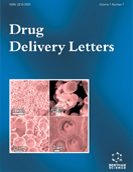Abstract
Gout is a painful disease of joints generated because of the deposition of urate crystals within the joints. Uricase is an enzyme capable of degrading less water soluble urate crystals into a compound allantoin, which is more water soluble and hence is easily excreted. Uricase being proteinaceous is degraded by the protein digestive enzymes of gastro intestinal tract (GIT) when administered orally. Colonic part of GIT lacks protein digestive enzymes and thus provides suitable conditions for the absorption of uricase. Colon consists of several microbial flora which secrete enzymes capable of degradation of alginates and pectin which are not digested by upper GI tract. Eudragit S-100 (pH sensitive polymer) coated alginate – pectinate microbeads were found to be effective for delivery of uricase directly to the colonic site. Sodium taurocholate, a bile salt, was found to be suitable for the effective absorption of uricase from colonic site into the systemic circulation.
Keywords: Colon targeting, Enzyme, Enzyme therapy, Gout, Hyperuricemia, Microbeads, Uricase.
Drug Delivery Letters
Title:Fabrication and Evaluation of Colon Targeted Uricase Containing Microbeads for Treatment of Gout
Volume: 3 Issue: 1
Author(s): Harinath Dwivedi, Kusum Agarwal and Shubhini A Saraf
Affiliation:
Keywords: Colon targeting, Enzyme, Enzyme therapy, Gout, Hyperuricemia, Microbeads, Uricase.
Abstract: Gout is a painful disease of joints generated because of the deposition of urate crystals within the joints. Uricase is an enzyme capable of degrading less water soluble urate crystals into a compound allantoin, which is more water soluble and hence is easily excreted. Uricase being proteinaceous is degraded by the protein digestive enzymes of gastro intestinal tract (GIT) when administered orally. Colonic part of GIT lacks protein digestive enzymes and thus provides suitable conditions for the absorption of uricase. Colon consists of several microbial flora which secrete enzymes capable of degradation of alginates and pectin which are not digested by upper GI tract. Eudragit S-100 (pH sensitive polymer) coated alginate – pectinate microbeads were found to be effective for delivery of uricase directly to the colonic site. Sodium taurocholate, a bile salt, was found to be suitable for the effective absorption of uricase from colonic site into the systemic circulation.
Export Options
About this article
Cite this article as:
Dwivedi Harinath, Agarwal Kusum and Saraf Shubhini A, Fabrication and Evaluation of Colon Targeted Uricase Containing Microbeads for Treatment of Gout, Drug Delivery Letters 2013; 3 (1) . https://dx.doi.org/10.2174/2210304x11303010007
| DOI https://dx.doi.org/10.2174/2210304x11303010007 |
Print ISSN 2210-3031 |
| Publisher Name Bentham Science Publisher |
Online ISSN 2210-304X |
 16
16
- Author Guidelines
- Bentham Author Support Services (BASS)
- Graphical Abstracts
- Fabricating and Stating False Information
- Research Misconduct
- Post Publication Discussions and Corrections
- Publishing Ethics and Rectitude
- Increase Visibility of Your Article
- Archiving Policies
- Peer Review Workflow
- Order Your Article Before Print
- Promote Your Article
- Manuscript Transfer Facility
- Editorial Policies
- Allegations from Whistleblowers
Related Articles
-
Immunotoxicity and Immunogenicity of Biopharmaceuticals: Design Concepts and Safety Assessment
Current Drug Safety System Models, Assays and Endpoint Parameters to Evaluate Anticancer Compounds During Preclinical Screening
Current Medicinal Chemistry Inhibition of c-Met with the Specific Small Molecule Tyrosine Kinase Inhibitor SU11274 Decreases Growth and Metastasis Formation of Experimental Human Melanoma
Current Cancer Drug Targets Context-dependent Action of Transforming Growth Factor β Family Members on Normal and Cancer Stem Cells
Current Pharmaceutical Design Advances in Exploring the Role of Micrornas in Inflammatory Bowel Disease
MicroRNA Recent Developments in Chimeric NSAIDs as Anticancer Agents: Teaching an Old Dog a New Trick
Mini-Reviews in Medicinal Chemistry Association between Serum Vitamin D Level and Echocardiographic Abnormalities in Patients with Thalassemia Major
Cardiovascular & Hematological Disorders-Drug Targets Mucosal Immune Regulation and Vaccines for Helicobacter-associated Gastritis
Current Chemical Biology Genomic Organization and Control of the Grb7 Gene Family
Current Genomics Melatonin, Autophagy and Intestinal Bowel Disease
Current Pharmaceutical Design Clinical Proteomics in Cancer Research
Current Proteomics Association Between Chlamydia pneumoniae Antibodies and Lung Cancer: A Meta-Analysis
Current Respiratory Medicine Reviews Amphiphilic Cyclodextrin Derivatives for Targeted Drug Delivery to Tumors
Current Topics in Medicinal Chemistry Neurotransmitters and Chemokines Regulate Tumor Cell Migration: Potential for a New Pharmacological Approach to Inhibit Invasion and Metastasis Development
Current Pharmaceutical Design Selectively Replicating Adenoviruses for Oncolytic Therapy
Current Cancer Drug Targets A Validated Stability-Indicating HPTLC Method for the Estimation of Capecitabine in its Tablet Dosage Form
Current Pharmaceutical Analysis Molecular Markers for Individualized Therapy in Colorectal Cancer: Progress Towards a Pharmacogenomics Array
Current Pharmacogenomics and Personalized Medicine Progress in the Discovery of Polo-like Kinase Inhibitors
Current Topics in Medicinal Chemistry Epigenetic and Disease Targets by Polyphenols
Current Pharmaceutical Design The High Mobility Group A1 (HMGA1) Transcriptome in Cancer and Development
Current Molecular Medicine


























